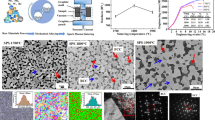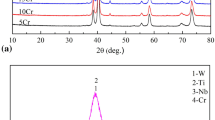Abstract
Refractory high-entropy alloys (RHEAs) are an emerging group of materials exhibiting interesting functional and structural properties under high-temperature operations. In this work, MoNbZrTiV RHEA particles were developed via high-energy mechanical alloying, employing sequential and conventional milling approaches. Microstructural analysis was done through scanning electron microscopy, and the corresponding energy-dispersive X-ray spectroscopy confirmed the successful formation of the alloy. Results showed that as the milling progressed, dissolution of the elements and homogenization of the alloy were greatly governed by the physical properties of the elements. Thermodynamic calculations predicted the formation of a solid solution with a body-centered cubic (BCC) crystal structure. The reduced particle size after 24 h of milling was mainly due to the brittle nature of the elements having BCC and hexagonal close-packed (HCP) crystal structures, in addition to strain hardening and the frequent tendency of fracturing than cold welding during milling.
Access this chapter
Tax calculation will be finalised at checkout
Purchases are for personal use only
Similar content being viewed by others
References
Senkov ON, Miracle DB, Chaput KJ, Couzinie JP (2018) Development and exploration of refractory high entropy alloys—a review. J Mater Res 33(19):3092–3128. https://doi.org/10.1557/jmr.2018.153
Cantor B, Chang ITH, Knight P, Vincent AJB (2004) Microstructural development in equiatomic multicomponent alloys. Mater Sci Eng A 375–377(1–2):213–218. https://doi.org/10.1016/j.msea.2003.10.257
Yeh JW et al (2004) Nanostructured high-entropy alloys with multiple principal elements: Novel alloy design concepts and outcomes. Adv Eng Mater 6(5):299–303. https://doi.org/10.1002/adem.200300567
Miracle DB, Miller JD, Senkov ON, Woodward C, Uchic MD, Tiley J (2014) Exploration and development of high entropy alloys for structural applications. Entropy 16(1):494–525. https://doi.org/10.3390/e16010494
Senkov ON, Wilks GB, Miracle DB, Chuang CP, Liaw PK (2010) Refractory high-entropy alloys. Intermetallics 18(9):1758–1765. https://doi.org/10.1016/j.intermet.2010.05.014
Chen Y, Li Y, Cheng X, Wu C, Cheng B, Xu Z (2018) The microstructure and mechanical properties of refractory high-entropy alloys with high plasticity. Materials (Basel) 11(2). https://doi.org/10.3390/ma11020208
Juan CC et al (2016) Simultaneously increasing the strength and ductility of a refractory high-entropy alloy via grain refining. Mater Lett 184:200–203. https://doi.org/10.1016/j.matlet.2016.08.060
Torralba JM, Alvaredo P, García-Junceda A (2020) Powder metallurgy and high-entropy alloys: update on new opportunities. Powder Metall 63(4):227–236. https://doi.org/10.1080/00325899.2020.1807713
Manogar B, Yang F, Bolzoni L (2022) Correlation between microstructure and tensile properties of powder metallurgy Ti-6Nb-x(Fe or Mn) alloys. J Alloys Compd 926:166805. https://doi.org/10.1016/j.jallcom.2022.166805
Gao MC, Liaw PK, Yeh JW, Zhang Y (2016) High-entropy alloys: fundamentals and applications. High-Entropy Alloy Fundam Appl 1–516. https://doi.org/10.1007/978-3-319-27013-5
Vaidya M, Prasad A, Parakh A, Murty BS (2017) Influence of sequence of elemental addition on phase evolution in nanocrystalline AlCoCrFeNi: Novel approach to alloy synthesis using mechanical alloying. Mater Des 126:37–46. https://doi.org/10.1016/j.matdes.2017.04.027
Han ZD et al (2017) Effect of Ti additions on mechanical properties of NbMoTaW and VNbMoTaW refractory high entropy alloys. Intermetallics 84:153–157. https://doi.org/10.1016/j.intermet.2017.01.007
Wang M, Ma ZL, Xu ZQ, Cheng XW (2021) Effects of vanadium concentration on mechanical properties of VxNbMoTa refractory high-entropy alloys. Mater Sci Eng A 808. https://doi.org/10.1016/j.msea.2021.140848
Kang B, Lee J, Ryu HJ, Hong SH (2018) Ultra-high strength WNbMoTaV high-entropy alloys with fine grain structure fabricated by powder metallurgical process. Mater Sci Eng A 712:616–624. https://doi.org/10.1016/j.msea.2017.12.021
Qiao Y et al (2020) Preparation of TiZrNbTa refractory high-entropy alloy powder by mechanical alloying with liquid process control agents. Intermetallics 126:106900. https://doi.org/10.1016/j.intermet.2020.106900
Zhang Y, Zhou YJ, Lin JP, Chen GL, Liaw PK (2008) Solid-solution phase formation rules for multi-component alloys. Adv Eng Mater 10(6):534–538. https://doi.org/10.1002/adem.200700240
Guo S, Liu CT (2011) Phase stability in high entropy alloys: Formation of solid-solution phase or amorphous phase. Prog Nat Sci Mater Int 21(6):433–446. https://doi.org/10.1016/S1002-0071(12)60080-X
Martin P, Madrid-Cortes CE, Cáceres C, Araya N, Aguilar C, Cabrera JM (2022) HEAPS: a user-friendly tool for the design and exploration of high-entropy alloys based on semi-empirical parameters. Comput Phys Commun 278:108398. https://doi.org/10.1016/j.cpc.2022.108398
Guo S, Ng C, Lu J, Liu CT (2011) Effect of valence electron concentration on stability of fcc or bcc phase in high entropy alloys. J Appl Phys 109(10). https://doi.org/10.1063/1.3587228
Huang M, Jiang J, Wang Y, Liu Y, Zhang Y (2022) Effects of milling process parameters and PCAs on the synthesis of Al0.8Co0.5Cr1.5CuFeNi high entropy alloy powder by mechanical alloying. Mater Des 217:110637. https://doi.org/10.1016/j.matdes.2022.110637
Acknowledgements
The authors would like to acknowledge with gratitude the Natural Sciences and Engineering Research Council of Canada (NSERC), the Canada Foundation for Innovation (CFI), Transport Canada, the Atlantic Canada Opportunities Agency (ACOA), and the New Brunswick Innovation Foundation (NBIF) for funding this research endeavor.
Author information
Authors and Affiliations
Corresponding author
Editor information
Editors and Affiliations
Rights and permissions
Copyright information
© 2024 The Minerals, Metals & Materials Society
About this paper
Cite this paper
Tolentino, M.S., Custodio, A.G.D., Saha, G.C., Aranas, C. (2024). Microstructural Analysis of MoNbZrTiV Refractory High-Entropy Alloy Developed via High-Energy Mechanical Alloying. In: TMS 2024 153rd Annual Meeting & Exhibition Supplemental Proceedings. TMS 2024. The Minerals, Metals & Materials Series. Springer, Cham. https://doi.org/10.1007/978-3-031-50349-8_57
Download citation
DOI: https://doi.org/10.1007/978-3-031-50349-8_57
Published:
Publisher Name: Springer, Cham
Print ISBN: 978-3-031-50348-1
Online ISBN: 978-3-031-50349-8
eBook Packages: Chemistry and Materials ScienceChemistry and Material Science (R0)




